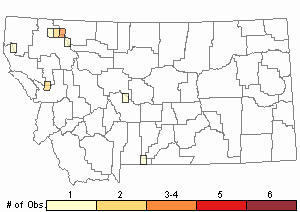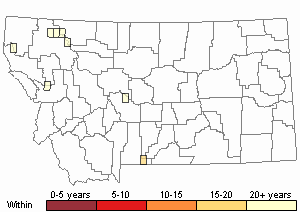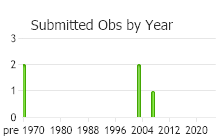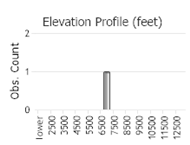View in other NatureServe Network Field Guides
NatureServe
Montana
Utah
Wyoming
Idaho
Wisconsin
British Columbia
South Carolina
Yukon
California
New York
A Pseudoleskea Moss - Pseudoleskea incurvata
Other Names:
Lescuraea incurvata
General Description
Plants: Pleurocarpous, growing in deep mats, green, or green with yellow, orange, or seldom black tones, becoming brown over time. Stems sizeable, catkin-like with the tips hooked upward, freely branched, possessing a central strand; paraphyllia forked, numerous (FNA 2014), especially on stems, occasionally scarce on branches (Lawton 1971); rhizoids borne in groups on leaves near the leaf attachment (FNA 2014).
Leaves: Lying next to the stem and overlapping when dry, spreading to about 45 degrees when damp, 0.8-2.5 mm in length, egg-shaped or more lance-shaped with ovate tendencies, typically curved in sickle-like fashion and sometimes pointing toward one side of the stem, tapering suddenly to a narrowly-angled apex, which may form a short acumen (seldom long), without a hair-point; leaf edges strongly curved back and downward from below almost to the acumen, smooth to finely saw-toothed above; costa extending to the leaf tip or nearly so, occasionally faintly wavy, tinged with orange (FNA 2014). Branch leaves a little smaller than the stem leaves (Lawton 1971).
Leaf Cells: Lower laminal cells generally shorter but otherwise resembling medial cells; medial cells variable, some about as broad as long, with ends of overlapping cells protruding and wall thickness medium to very thick, nonporose; alar cells somewhat long or square, the area large, the longer dimension crosswise to the length of the leaf (FNA 2014).
Pseudoleskea incurvata var. incurvata: Present in Montana. Plants moderately-sized with numerous long branches; leaves 1-1.5 mm in length, the distal end suddenly narrowly-angled or forming a somewhat short acumen; papillae from protruding cell ends evident (FNA 2014).
Pseudoleskea incurvata var. gigantea: Plants large with several or no branches; leaves 1.5-2.5 mm in length, the acumen long; papillae from protruding cell ends obscure (FNA 2014).
Pseudoleskea incurvata var. tenuiretis: Present in Montana. Plants small with numerous short branches; leaves 0.8-1.1 mm in length, the distal end suddenly narrowly-angled or forming a short acumen; papillae from protruding cell ends evident (FNA 2014).
Phenology
Fruit ripens in summer (FNA 2014).
Range Comments
Known Montana Range
Pseudoleskea incurvata known from Flathead, Glacier, Lake, Lincoln, Meagher, and Missoula Counties.
Variety incurvata known from Flathead, Glacier, and Missoula Counties.
Variety tenuiretis known from Glacier County.
Reference: Elliott and Pipp 2016.
North American Range
Variety incurvata: AK and NT, BC and AB s to CA, NV, UT, and MT, also CO and MI.
Variety gigantea: BC to CA and ID.
Variety tenuiretis: BC and AB, MT, CA, and UT.
Reference: Adapted from FNA 2014.
Observations in Montana Natural Heritage Program Database
Number of Observations: 13
(Click on the following maps and charts to see full sized version)
Map Help and Descriptions
Relative Density

Recency



 (Observations spanning multiple months or years are excluded from time charts)
(Observations spanning multiple months or years are excluded from time charts)
Habitat
Variety incurvata: Boulders and soil beside watercourses. Ranging from mid-elevations to 10,830 feet (FNA 2014).
Variety gigantea: Soil overlying crags and large stones. Ranging from mid-elevations to 6890 feet (FNA 2014).
Variety tenuiretis: Large, dry stones and soil. Ranging from mid-elevations to 7870 feet (FNA 2014).
Reference: Adapted from FNA 2014.
Reproductive Characteristics
Dioicous (FNA 2014). Seta sometimes reaching 15 mm in height (Lawton 1971). Capsule upright or nearly so, 1-2.5 mm in length; exostome teeth taller than the endostome processes; cilia present (FNA 2014).
Variety tenuiretis: Sporophytes seldom produced (FNA 2014).
Stewardship Responsibility
References
- Literature Cited AboveLegend:
 View Online Publication
View Online Publication Elliott, J.C. and A.K. Pipp. 2018. A Checklist of Montana Mosses (1880-2018). Updated 3 January, 2020. Montana Natural Heritage Program, Helena, Montana. 73 pp.
Elliott, J.C. and A.K. Pipp. 2018. A Checklist of Montana Mosses (1880-2018). Updated 3 January, 2020. Montana Natural Heritage Program, Helena, Montana. 73 pp. Flora of North America Editorial Committee, eds. 2014. Flora of North America North of Mexico. Volume 28. Bryophytes: Mosses, Part 2. Oxford University Press, Inc., NY. xxi + 702 pp.
Flora of North America Editorial Committee, eds. 2014. Flora of North America North of Mexico. Volume 28. Bryophytes: Mosses, Part 2. Oxford University Press, Inc., NY. xxi + 702 pp. Lawton, E. 1971. Moss Flora of the Pacific Northwest. Hattori Botanical Laboratory. Japan: Yamabuki-cho, Shinjuku-ku, Tokyo. 362 pages plus appendices.
Lawton, E. 1971. Moss Flora of the Pacific Northwest. Hattori Botanical Laboratory. Japan: Yamabuki-cho, Shinjuku-ku, Tokyo. 362 pages plus appendices.
- Additional ReferencesLegend:
 View Online Publication
View Online Publication
Do you know of a citation we're missing? Elliot, J. C. 1993. Second checklist of Montana mosses. Unpublished report. U.S. Forest Service, Region 1. Missoula, MT. 45 pp.
Elliot, J. C. 1993. Second checklist of Montana mosses. Unpublished report. U.S. Forest Service, Region 1. Missoula, MT. 45 pp. Flowers, S. 1973. Mosses: Utah and the West. Brigham Young University, Provo, Utah. 567 p.
Flowers, S. 1973. Mosses: Utah and the West. Brigham Young University, Provo, Utah. 567 p. Lawton, E. 1971. Keys for the Identification of the Mosses on the Pacific Northwest. Reprinted from 'Moss Flora of the Pacific Northwest'. Published as Supplement No. 2 of the Journal of the Hattori Botanical Laboratory. Nichinan, Miyazaki, Japan. 66 pp.
Lawton, E. 1971. Keys for the Identification of the Mosses on the Pacific Northwest. Reprinted from 'Moss Flora of the Pacific Northwest'. Published as Supplement No. 2 of the Journal of the Hattori Botanical Laboratory. Nichinan, Miyazaki, Japan. 66 pp. Malcolm, B., N. Malcolm, J. Shevock, and D. Norris. 2009. California Mosses. Nelson, New Zealand: Micro-Optics Press. 430 pp.
Malcolm, B., N. Malcolm, J. Shevock, and D. Norris. 2009. California Mosses. Nelson, New Zealand: Micro-Optics Press. 430 pp. Smith, A.J.E. 1980. The Moss Flora of Britain and Ireland. Cambridge University Press, Cambridge. 705 pp.
Smith, A.J.E. 1980. The Moss Flora of Britain and Ireland. Cambridge University Press, Cambridge. 705 pp.
- Web Search Engines for Articles on "A Pseudoleskea Moss"





